The past year has shown exciting opportunities at the intersection of technology and strategy, given massive developments in Generative Artificial Intelligence (Generative AI). The technology's progression is no longer merely an item on the CTO's agenda but a focus for the entire leadership team due to the massive potential impact on revenue and costs.
SaaS leaders anticipate over 10% revenue growth in the next two years from integrating Generative AI features into their platforms. Despite optimistic expectations, the critical question remains: How will SaaS companies ensure this revenue potential is realized?
The ability of Generative AI to autonomously generate unique, user-tailored content raises questions around monetization, resulting in a dilemma: whether to charge for these innovative features and monetize them directly or to monetize them indirectly by enhancing product value and customer experience. Previously, a new customer did not significantly contribute to a SaaS company’s variable costs. However, the high variable cost of Generative AI usage, which a new customer may create, changes the monetization game and adds complexity. In other words, monetizing Generative AI may be complicated but essential for lasting impact. Yet, in our experience, most SaaS companies do not yet have a clear and effective monetization strategy.
This article provides SaaS leaders with practical insights on monetizing AI features to realize sustainable revenue growth. It showcases the importance of working on Generative AI features while monetizing these features by striking a balance between charging for these features and giving customers care-free access at no cost. Furthermore, practical pointers are provided to guide the decision on how to charge for Generative AI features in your packaging and pricing model when choosing the route of monetization.
Should SaaS companies develop Generative AI features?
Developing customer-facing Generative AI functions serves a dual purpose: enhancing customer experience and maintaining competitiveness in a rapidly evolving landscape. First and foremost, implementing Generative AI in SaaS is a move that can make your product more customer-centric. By harnessing the power of generative functionalities, SaaS leaders can elevate their offerings to be more intelligent, efficient, and tailored to specific customer needs, leading to a competitive advantage in the broad landscape of software services.
Furthermore, the imperative to develop Generative AI features to stay competitive is evident: Our global software study shows that 12% of SaaS leaders already have launched features, and 80% of SaaS leaders expect to launch them in the next 18 months. In other words, only 8% of SaaS leaders are not planning to work on these features or expect it to take longer than 18 months. If the question of implementing Generative AI features for your company has yet to be addressed, the urgency to answer it becomes clear.
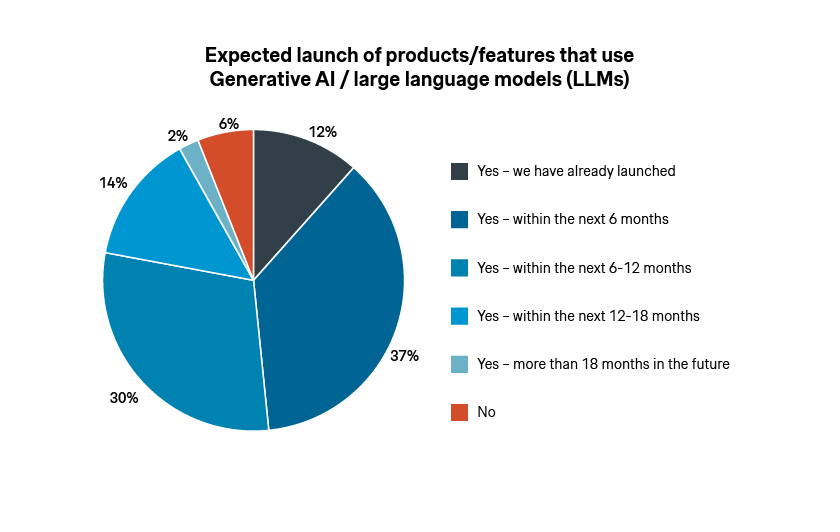
Clearly, based on the two factors mentioned above, there is a solid case to integrate Generative AI features or services into your SaaS business. Nevertheless, we recommend carefully considering the prospective value and challenges it can deliver. It is imperative to ask: Will AI-driven features align with your current product offerings and the needs of your customer base? Are the benefits (e.g., customer experience and competitiveness) expected to outweigh the costs (e.g., development cost and API usage)? Are you equipped with the required technological infrastructure and expertise to implement and maintain these features? Moreover, ethical considerations and regulatory compliance regarding data usage and AI generation should be meticulously navigated.
Your SaaS business is likely to yield positive results from integrating Generative AI features if your features seamlessly integrate with your value proposition, effectively tackle genuine customer pain points, and exhibit positive outcomes through a thorough cost-benefit analysis (validating economic, operation, and ethical feasibility).
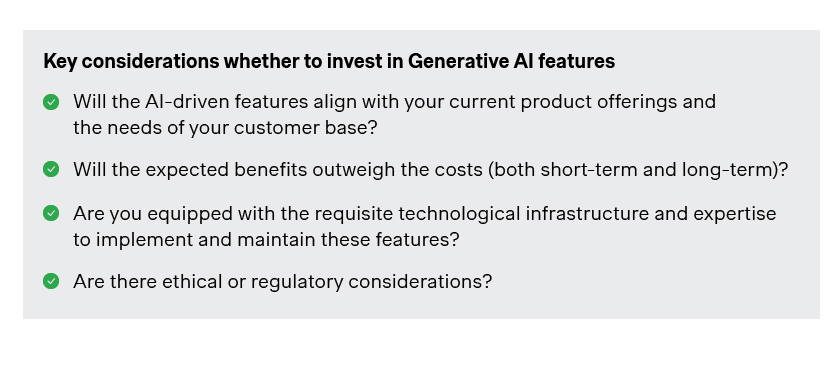
Monetizing Generative AI: direct vs indirect
The expectations on the economic feasibility of generative AI features are high. More than two-thirds of SaaS leaders have an optimistic outlook and expect over 10% growth within the ensuing two years by integrating Generative AI features into their platforms. The expectations are sizeable, yet it raises the question: How precisely will the additional revenue be realized, and through what mechanisms will it find its way into the financial streams of the business?
New SaaS businesses typically first focus on finding product-market fit by developing a product with a sizable customer base that clearly addresses customer needs. This is what most Generative AI applications find themselves focusing on right now. More established SaaS businesses then typically focus on developing a sustainable business model by monetizing the value they deliver to their customers. We expect this is a crucial shift that most Generative AI applications will need to make to realize the expected incremental revenue and build a lasting business.
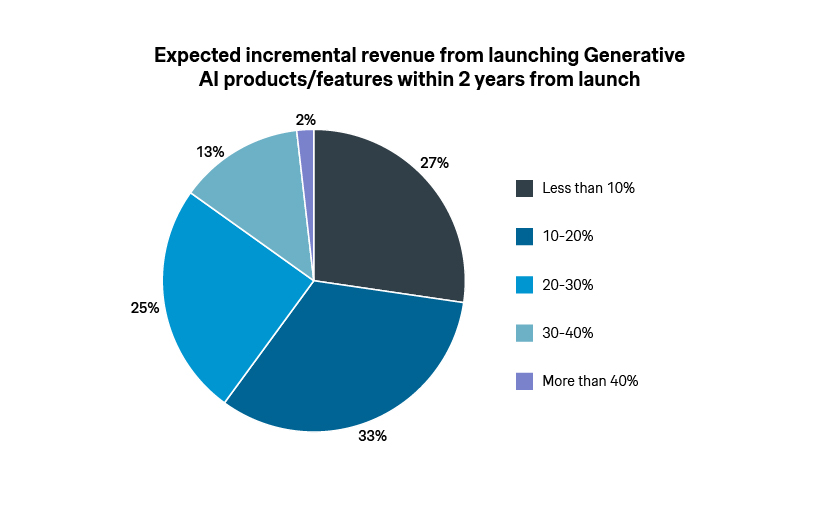
An essential factor in value monetization is whether to monetize generative AI features directly (either by charging a separate fee or through a price increase) or to monetize features indirectly (i.e., by realizing revenue uplift without charging for the Generative AI features).
The rule of thumb is that if generative AI features significantly increase a usage-based price metric or if they significantly increase customer conversion or retention in a much greater way, then it is likely more advantageous not to impose charges for Generative AI features as revenue gains are realized indirectly. We typically find, however, that these indirect benefits are insufficient for sustainable monetization.
In cases where indirect monetization is insufficient, providing access to all customers paired with a price increase of the core product is likely justified, as the product is enhanced with a net-new technology, which improves the value it delivers to customers and likely improves the value delivered compared to competitors. This aligns with the industry practice of tying incremental pricing to continuous feature and functionality enhancements in subscription models. Essential to this is ensuring that all customers recognize the added value of Generative AI features and are willing to pay for them. If the latter does not apply, a separate fee (e.g., by only offering it in a premium tier, by introducing a usage-based metric, or by charging a fixed add-on fee) is optimal.
The logic above applies to Generative AI and other new product features. However, a critical consideration that is especially relevant to Generative AI and which may overrule offering the feature to everyone with or without a price increase is the variable costs of Generative AI (e.g., cost of API queries, bandwidth, etc.). Despite falling variable costs of Generative AI usage and clever innovations that, for instance, select the most cost-efficient model depending on the task at hand, variable costs of some AI applications are often still non-neglectable. If the variable cost of a Generative AI feature is excessive, it is likely a good idea to charge a separate fee for these features or set an overage fee for active use.
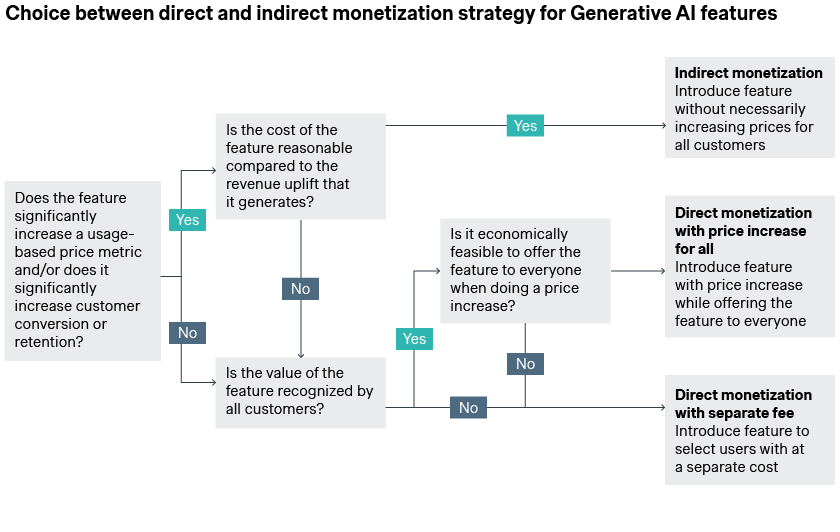
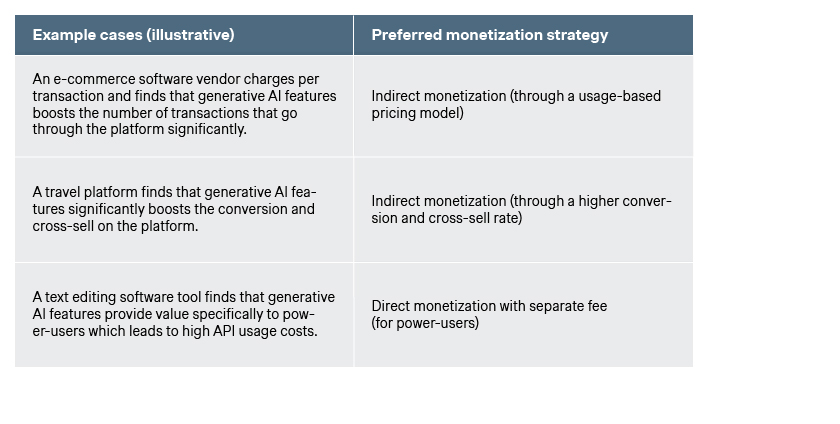
What is the most effective packaging and pricing model for Generative AI?
SaaS companies that offer Generative AI features handle this very differently from each other, even when offering a similar use case.
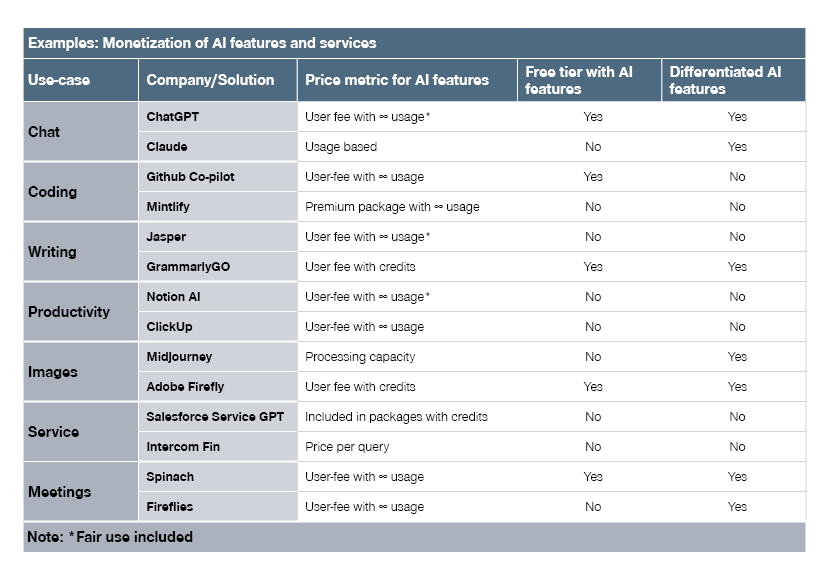
How to structure Generative AI features in a packaging and pricing model?
At Simon-Kucher, we typically recommend differentiating software solutions into different packages to address different needs and levels of willingness to pay. This also creates opportunities to create a land-and-expand structure in which customers create up-sell over time.
However, we find that most SaaS companies do not currently differentiate their AI features between packages, which we expect will occur more over time as AI solutions become richer in features. Companies that do currently differentiate AI features only differentiate based on usage and less so on functionality.
Another opportunity that differentiation can bring is limiting costs of AI API costs. For example, ChatGPT differentiates based on usage limits as well as features (e.g., GPT-4 processing, faster response times, ability to do data analyses, ability to connect plugins, etc.) between their free tier and their Plus tier. As a result, the company provides a compelling entry package that can serve at a lower operating cost whilst stimulating the upsell to more premium paid packages.
Hence, we recommend differentiating the AI features between packages if there are sufficient means to create an attractive land-and-expand structure or if this provides opportunities for significant cost savings (while remaining appealing to the customer). A fair-use policy can help to not turn the package differentiation about AI usage if that does not correspond to how the customer experiences the value of the AI feature.
Start monetizing Generative AI
What is the price formula for the AI proposition?
Usage-based pricing has been a clear pricing trend across the SaaS industry in recent years. Although a user-based fee with unlimited usage seems the most prevalent for Generative AI solutions, the market shows different answers, e.g., GitHub Co-pilot has a fixed fee of $30 per month, whereas Adobe Firefly offers a subscription with credits. The most typical metrics are a user-based fee with unlimited usage (most common), a user-based fee with a certain amount of credits included with overage being charged separately, and a fee per query or API call without a fixed fee for using the Generative AI feature.
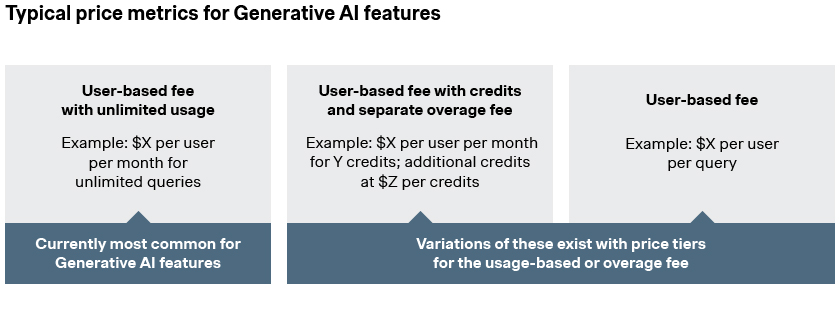
The challenge with user fees is that usage typically varies significantly between users. That, in practice, means that the value that users derive from the Generative AI features differs, as well as the API usage costs that the users generate. For one user, the price may be too high, prohibiting adoption, whereas for another, the price may be too low. This is illustrated by a recent Wall Street Journal article, suggesting that Github Co-pilot (which has a fixed price per user) was losing more than $20 a month per user, with some heavy users costing as much as $80 per month. Usage-based pricing has the potential to resolve that, though the counter side to user-pricing is that a fully usage-based fee may lead to the “taxi-meter effect”: the discomfort of mentally linking every unit of usage to an increase in price, which harms feature adoption.
Simon-Kucher typically recommends that a price metric should i) be attractive/explainable to customers, ii) scale with customer growth/success, and iii) be implementable / financially feasible. The same applies to the price metrics for Generative AI. By often being very explainable to the customer, we find that in most cases, a user-based fee for generative AI that guarantees fair usage (and hence limits the taxi-meter effect) and which has fences in place to up-sell heavy users is optimal. However, exceptions apply where usage-based tend to be more explainable to customers. Ultimately, we therefore recommend doing customer research to find the preferred metric.
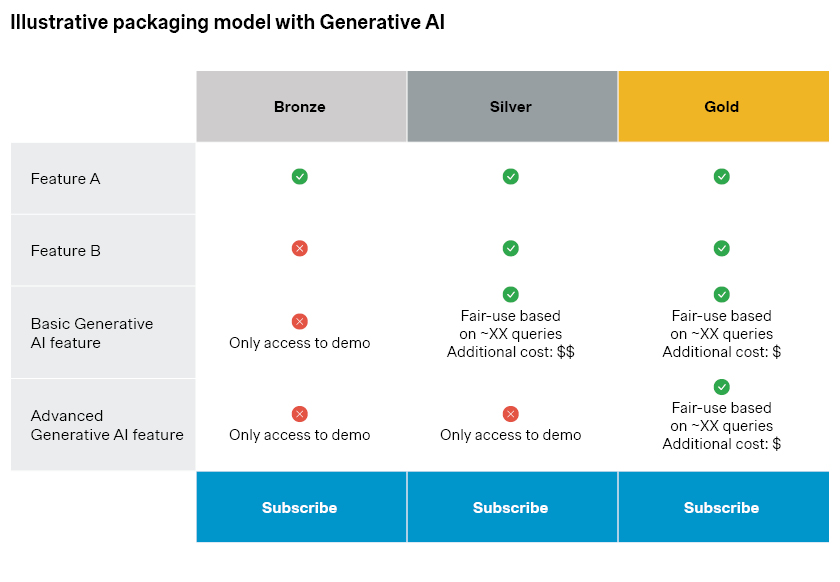
Are you interested in how we can support you to make Generative AI a commercial success for your business? We can help you think about use cases to leverage the potential of Generative AI, and we can provide a data-driven perspective to help you decide how to monetize AI in the best possible way. Feel free to contact us to discuss how you can best monetize your offering.
The authors wish to thank Tommy van Thiel (Senior Consultant), and Amber van Ginkel (Consultant) for their contribution to this article.








